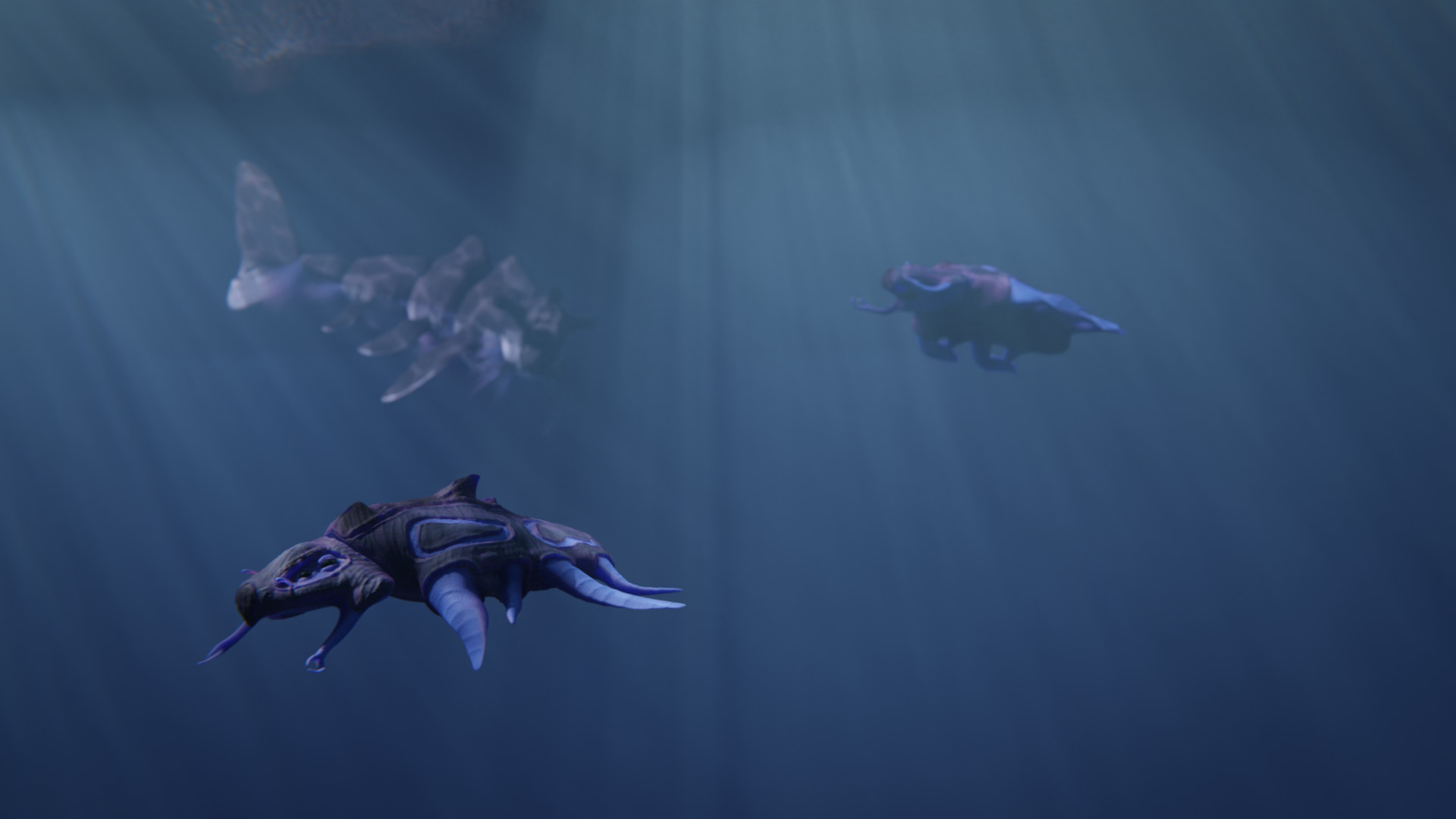Magnopeus
In the relatively shallow seas Between Kub Shay and Yama a placid creature swims from place to place grazing on retinalphytes and the occasional sessile or slow moving creature such as rose limpets. This creature, the magnopeus, as an adult has essentially no predators, as it is protected by thick armor. Pictured here, a pair of magnopeus swim to a new feeding ground while being investigated by a curious xenopistris. [creature design by Kipzilla]
Basic Information
Anatomy
The eight short stubby legs of durospina have evolved into flippers so it could move more freely and faster through the water, this change made it able to gather more food and gives it a bigger foraging range. The original Durospina shell which was more rounded has evolved into a flatter, wider and more hydrodynamic shape to reduce drag and to reduce the chance of predators eating it when young. The internal gas bladder has split off from the walking durspina descendants by splitting into two one on each side of the body, this increases its buoyancy but makes it a bit slower to swim and turn, the bladders are filled with digestive gasses and can also be used for storage where plant material can ferment to be better digestible. The mouth is reinforced with armor forming a sort of beak that can cut of parts of plants. The stomach of the magnopeus has extended into the posterior tagma to allow for extra space and the ability of digestive gasses to easy reach the gas bladder through specialized networks of filters.
Magnopeus are resistant to the toxins of various pelagic phytozoans, which it will opportunistically feed on.
Genetics and Reproduction
Magnopeus has two sexes, male and female. When the mating season starts the females will secrete hormones that indicate that they are fertile and the males will be able to smell this and meet up with them, here the females will eject their gametes into the water in a big cloud and secrete a smell that triggers the male to release his gametes. The male and female gametes will then combine in the water and form a thick protective coating layer around themselves and fall to the bottom after using a semipermeable membrane to reduce their total volume by osmosis.
On the ocean floor they will lay for almost a week, and develop into a small larvae with fins but otherwise resembling the ancestral dyomisa. This baby magnopeus will then grow bigger and bigger over the next years and be fully developed and ready to mate at age three and a half local years.
Each mating event results in several thousand young, of which only a handful, often fewer than 10, will reach adulthood to themselves mate.
Each mating event results in several thousand young, of which only a handful, often fewer than 10, will reach adulthood to themselves mate.
Growth Rate & Stages
Starting off life as tiny soft bodied barely nektonic creatures, newly hatched magnopeus are easy prey for virtually anything interested in eating them. Over the course of the first year of life those juveniles who survive will grow quickly and by about a year and a half they will have a thick armored shell. From here they just grow in size increasingly unmolested by predators.
Ecology and Habitats
Magnopeus are resident in shallow waters all around the globe except in the vicinity of Niylan and the northern most reaches of coastal arctica. They are transient visitors to deeper waters where they will swim going from one feeding ground to another. During these transits they will take a bit or two from large pelagic phytozoans, this usually causes them to sim away, often faster than the magnopeus can swim, and so these feedings are just opportunistic snacks to help keep the magnopeus' energy stores up.
Dietary Needs and Habits
The magnopeus primarily feeds on photosynthetic organisms, but also will opportunistically take prey, primarily sessile or slow moving prey. They have large stomachs which can digest tough material, and they will typically gorge for a few days, then swim to a new feeding ground, vomiting up the waste from their previous meal, since they have a blind gut.











Comments